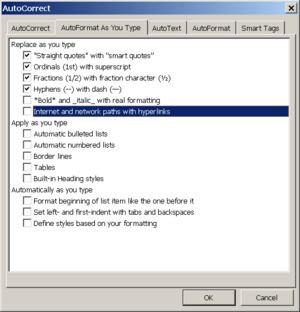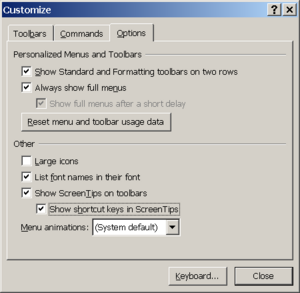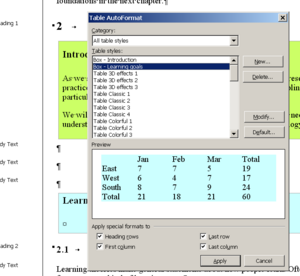Microsoft Word 2003: Difference between revisions
m (using an external editor) |
m (using an external editor) |
||
| Line 30: | Line 30: | ||
* File->Print | * File->Print | ||
* Then change "Print What" to Styles | * Then change "Print What" to Styles | ||
=== set up the toolbar === | |||
After a while you may want to use shortcuts (instead of the pulldown menus) | |||
Select ''tools->Customize->Toolbars'' | |||
* You can add/remove various groups of tools | |||
=== Set your preferences === | === Set your preferences === | ||
| Line 35: | Line 42: | ||
The basic idea is to turn off all "helpful" features, since they create havoc. | The basic idea is to turn off all "helpful" features, since they create havoc. | ||
Read Daiya's [http://daiya.mvps.org/wordsetup.htm Setting Up Word]. | Read Daiya's [http://daiya.mvps.org/wordsetup.htm Setting Up Word]. | ||
Select ''tools->Autocorrect Options'' and fix all tabs ... | |||
; Fix autocorrecting | ; Fix autocorrecting | ||
* This actually can't harm, it even can be useful | * This actually can't harm, it even can be useful (but you may go over each in option and the long list in "Replace as you type" | ||
; Fix ''AutoFormat As You Type'' | ; Fix ''AutoFormat As You Type'' | ||
* Take most everything off | * Take most everything off | ||
[[image:word2003-customize-autoformat.png|thumb|300px|none|Customize Word]] | [[image:word2003-customize-autoformat.png|thumb|300px|none|Customize Word]] | ||
* Tools->Options->Edit->Prompt to Update Style; Prompt to update style | * Tools->Options->Edit->Prompt to Update Style; Prompt to update style | ||
| Line 48: | Line 56: | ||
* When you create a style, "Add to template" | * When you create a style, "Add to template" | ||
; Tools->Customize-Options | ; Tools->Customize->Options | ||
I use these: | |||
[[image:word2003-customize-options.png|thumb|300px|none|Customize Word]] | [[image:word2003-customize-options.png|thumb|300px|none|Customize Word]] | ||
| Line 72: | Line 81: | ||
=== Repurposing of tables === | === Repurposing of tables === | ||
One possibility to get standardized boxes is to create a table with a single cell or maybe 2-3 cells in a single column. | |||
You have to define a new table style and give it a name. Typically you want to make the following changes in the autoformat style, i.e. not in each table. (table->Table AutoFormat->modify style) | |||
* Base style on Table Normal | |||
* Change Background color | |||
* Margins on top and bottom for the default cell. This will add some (colored spage) on top and bottom (e.g. what is normally called "padding"). | |||
* Margins left of the table | |||
Formatting elements inside the table can be same as the ones you use for ordinary text. | |||
In the insert table dialog (first time you use it): | |||
* set number of columns and rows to 1 | |||
* Autofit to Window | |||
* Tick "Remember ...." | |||
This sort of works, However, tables don't work very well either in MS Word, e.g. you can't for instance define a margin around a table (MS margings just do padding inside the table). Use a blank line for this.... | |||
You can't insert something between 2 tables (huh I must be dreaming). So insert a blank first, then another blank line, | |||
Finally, the quickest wat to insert a new table, created a blank line, then use ''Table-Autoformat''. Click on the table you want and then ''Apply''. | |||
[[image:word2003-using-tables-for-boxes.png|thumb|300px|none|Customize Word]] | |||
=== Macros === | === Macros === | ||
Revision as of 18:35, 13 August 2007
Introdcution
I (Daniel K. Schneider) rarely use Word and when I have to I find it extremly difficult to produce moderatly good look text (e.g. what would be expected in a textbook. In addition, Word does things to me I didn't ask for, e.g. create new styles or renumber items.
With a program like FrameMaker I can quite easily achieve what I want (in the past I also managed with formatting software) and it does not try to do things not told to do. Also I don't know anyone who even has a moderatly good working knowledge to do things efficiently.
Therefore I will try to make an effort to write down a few tricks I might learn. For the moment just a few links, since I (for now) have the impression that you can't create larger elements efficiently, e.g. vignettes with title, pargraphs of various forms and appropriate numbeing, or figures that include a title, automatic number of the caption...
General advice for Word 2003
If plan to work on a larger document I only have little advice to give for now
Use styles
That's so obvious that I won't go into it in detail.
To see, or change, the base of a style, modify the style. Via Format->Styles and Formatting you can display the Styles. This pane has five sections:
- On top: Current style: Click on it to modify
- Select All to select all text elements with this style, New Style to create a new style
- A list of the recently used styles
- A list of all other styles
- On the bottom, you can define which styles you want to see....
To print styles you have:
- File->Print
- Then change "Print What" to Styles
set up the toolbar
After a while you may want to use shortcuts (instead of the pulldown menus)
Select tools->Customize->Toolbars
- You can add/remove various groups of tools
Set your preferences
The basic idea is to turn off all "helpful" features, since they create havoc. Read Daiya's Setting Up Word.
Select tools->Autocorrect Options and fix all tabs ...
- Fix autocorrecting
- This actually can't harm, it even can be useful (but you may go over each in option and the long list in "Replace as you type"
- Fix AutoFormat As You Type
- Take most everything off
- Tools->Options->Edit->Prompt to Update Style; Prompt to update style
- Untick "Automatically update the style from now on" if by mistake it's on.
- When you create a style, "Add to template"
- Tools->Customize->Options
I use these:
How to manage special strands in a text
To problem is to find an efficient way to insert and specially mark various feature strands in a textbook, e.g. conclusions and summaries, list of definitions, reference boxes, review questions, self-assessment (usually simple quizzes), small exercises etc.
Styles
Make style for each element you plan to have in these feature strands, usually:
- A title
- paragraphs
- bullets
- Maybe a caption
If you use background color, you have to make sure that there is no blank space between.
Section breaks
- Sections allow to break down a document in to several sections, each of which may have different formatting. E.g. used to separate the first pages from the rest.
- Probably not that useful, since removing one of these may crate havoc
Repurposing of tables
One possibility to get standardized boxes is to create a table with a single cell or maybe 2-3 cells in a single column.
You have to define a new table style and give it a name. Typically you want to make the following changes in the autoformat style, i.e. not in each table. (table->Table AutoFormat->modify style)
- Base style on Table Normal
- Change Background color
- Margins on top and bottom for the default cell. This will add some (colored spage) on top and bottom (e.g. what is normally called "padding").
- Margins left of the table
Formatting elements inside the table can be same as the ones you use for ordinary text.
In the insert table dialog (first time you use it):
- set number of columns and rows to 1
- Autofit to Window
- Tick "Remember ...."
This sort of works, However, tables don't work very well either in MS Word, e.g. you can't for instance define a margin around a table (MS margings just do padding inside the table). Use a blank line for this.... You can't insert something between 2 tables (huh I must be dreaming). So insert a blank first, then another blank line,
Finally, the quickest wat to insert a new table, created a blank line, then use Table-Autoformat. Click on the table you want and then Apply.
Macros
E.g. O'Reilly provides for its authors a menu with macros to insert special text elements like figures.
A macro then would insert a series of emtpy paragraph, each one with an appropriate style.
Links
General Beginners and mid-level tutorials
These links are not sorted or commented (no time), but when I made them (August 2007) they all seemed to useful and have real contents. Most Google search for "Word XP tutorial" leads to utter junk ...
- http://www.uwec.edu/help/word03.htm Microsoft Word 2003, LTS Online Help Documentation, University of Wisconsin. Quite a good tutorial for both beginners and and somewhat advanced users.
- Word 2003 Courses at Microsoft.
- Tutorials at Rudgers Writing Program. Includes some good beginners tutorials for Word 2003.
- Word Tutorial I (PDF), Word XP, beginner's level, from UC Berkeley Calpact
- Word Tutorial II (PDF), Word XP, mid level, from UC Berkeley Calpact
- Microsoft Word. Three beginners tutorials from University Information services, Georgetown University
- Word 2000 Tutorial and Word 2007 Tutorial, Florida Gulf Coast University.
- Microsoft Word Modules from Intern4Classrooms (i4c).
- Tutorials - Microsoft Word at BetterSolutions.com
Word FAQ's
- The Word MVP site includes a great number of useful FAQs and mini-tutorials. Can help advanced users.
Tutorials on how to write a book with word
- So You Want to Write a Book with MS Word by Daiya Mitchell. This was the only useful link I found. The text includes links to the related The Word MVP site
- [http://daiya.mvps.org/bookword.htm One Professional�$B!G�(Bs Steps for Writing a Book] by John McGhie
Avaliable style sheets
(to write large documents, more needed)
- Microsoft has a large list of templates, e.g. Books (not useful for writing "real" books")
- O'Reilly
- BCS book template
Use of annotations
(comments for other readers)
- Editing Electronically Submitted Papers (Web by Design, Indiana University]
Software tools
- [http://www.self-pub.net/wizard.html Book Design Wizard 2.0 for Microsoft�.A�N. Word] ($35).


